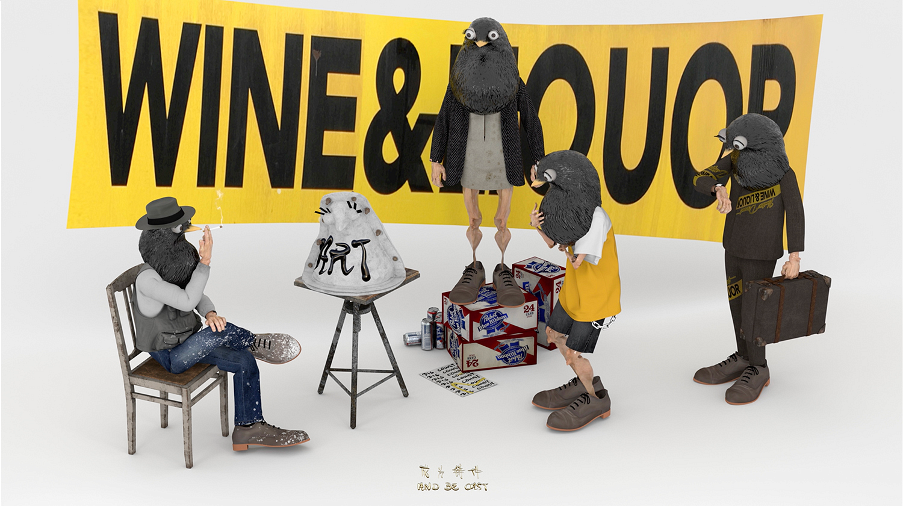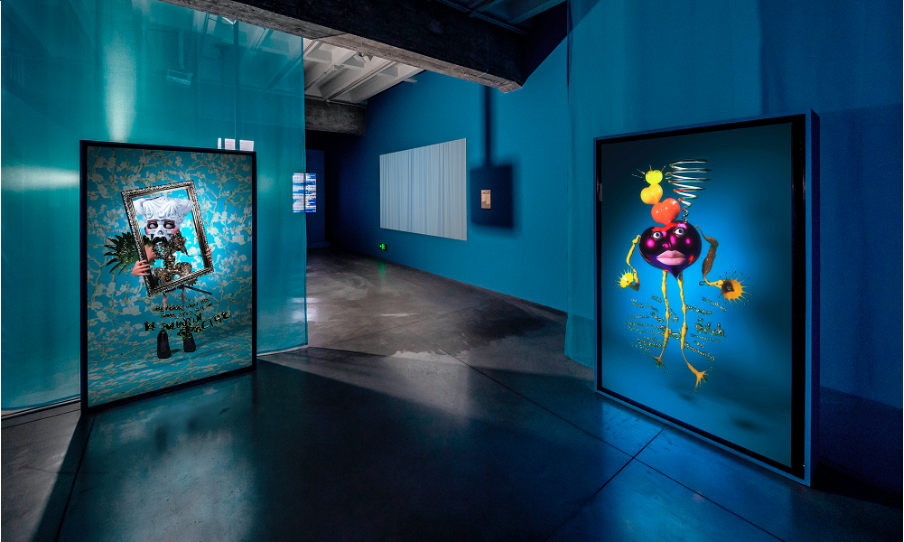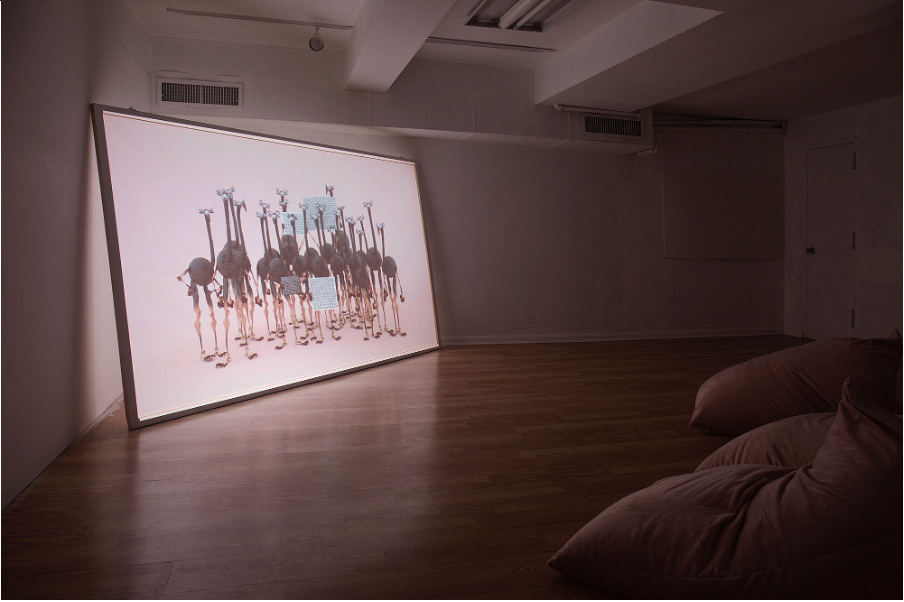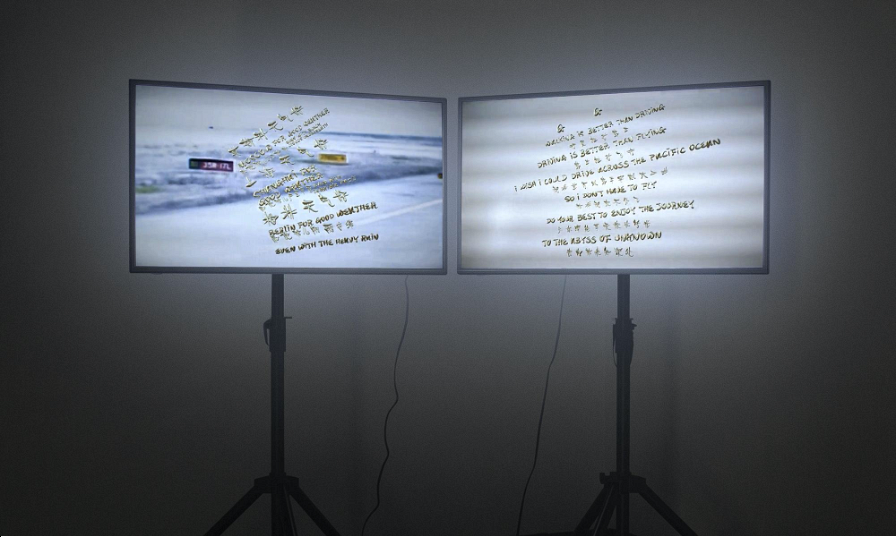Editor’s Note:
Heichi Magazine is glad to announce a new collaboration with the Hyundai Motorstudio Beijing, jointly presenting a collection of essays edited by curator Jenny Chen Jiaying. Under the rubric of her curated exhibition, AI: Love and Artificial Intelligence, currently on view in Hyundai Motorstudio Beijing, this special column presents three long-form essays by the participating artists.
Translator's Note:
Dichotomy implies not only a relationship between two poles but also a transitional space inbetween. As a participating artist in the exhibition AI: Love and Artificial Intelligence, Frank WANG Yefeng Wang reveals structural interstices through this essay and portrays the condition of inbetweeners, as well as their way of life. His work The Groundless Protag depicts the ghostly figures of subjects that reside between the real and the virtual–existing in liminal cyberspace, in the ephemeral but important space of the nomad–and try to invoke the viewer’s empathy by means of emotional outbursts that somehow salve our anxious and drifting present.
The year 2020 puts our existential condition in a state of “inbetweenness.” The viral catastrophe of COVID has forced us to lock down in fixed locations. With ongoing civil unrest and the political pandemonium at COVID’s heels, we are all caught up in this great moment of uncertainty and transition. Human rationality tends to shrink away from the future’s inherent unpredictability because it inspires great anxiety and can be perceived as a threat. Yet this year’s turmoil also provides an opportunity to reexamine our understanding of “normality” and scrutinize contemporary living in a time of contingency. The notion of inbetweenness, often subsumes, pertains to, or intersects with the term “liminality,” 1“Liminality” signifies a threshold between two zones, an anteroom distinct from that which could be said to be definitely inside or outside, here and there.” Downey, Dara, Ian Kinane, and Elizabeth Parker, eds. Landscapes of Liminality: Between Space and Place (London and New York: Rowman & Littlefield, 2016), Forward, xii. is hereby asserted as a universal consciousness of everyday life. The existential position of inbetweeners is a consistent human condition because “cultures and human lives cannot exist without moments of transition, and those brief and important spaces where we live through the in-between.” 2Thomassen, Bjørn. Liminality and the Modern: Living Through the In-Between (Surrey: Ashgate Publishing, 2014), p. 4.
This essay delves into ways of life amid uncertainties, embracing inbetweenness as an emancipatory tool, and projecting a path to the future with new kinds of productivity and creativity. It converges topics currently being widely discussed under the umbrella term of postmodernism. Coherent intellectual movements such as post-humanism, nomadism, and affect theory, among others, accordingly address inbetweenness as a productive expression of cultural transformation and hybridity beyond an assumed hierarchy. Their overlapping scholarly interests encourage us to confront the great delusions in our current system, which are often imposed by classic social categories, a dualistic structure of thinking, the spectacle of advanced capitalism, and assorted forms of political repression. Such movements urge us to reassess our relationship to the world with the prospect of yielding a “newness” that is better than whatever we are stuck with now. In an epoch of unprecedented fluctuation, our lives shaped by unpredictability no longer coincide with familiar traditions. The inhabitation and cultivation of inbetweenness can generate unimagined revelations for a new reality.
The urgency of understanding inbetweenness echoes my experience shared with multicultural communities that have adopted liminality as essential habitat. People who deal with cultural plurality due to relocation or who have left their places of kinship are generally considered to be migrants, whereas the nomad is closer to the spectrum of inbetweenness. Migration suggests an explicit beginning and end, settling in a fixed location by way of a set path. But to be a nomad denotes an endless expedition. According to Rosi Braittoti, the nomad is “beyond classification… a sort of classless unit.” 3Rosi Braidotti, Nomadic Subjects: Embodiment and Sexual Difference in Contemporary Feminist Theory (New York: Columbia University Press, 2011), p. 57. A nomadic relationship to various places and people is one of constant shift and multiplicity. It forms a non-unitary coexistence where no static identity is taken permanently. The ambivalent identities of inbetweeners respond and extend to not only tangible places but also to a wide variety of other territories, such as liminal cyberspace.
During the pandemic lock-down, a show titled AI: Love and Artificial Intelligence in Beijing attended to such philosophy through a creative praxis. Exploring the influence of algorithms on contemporary models of effect, the exhibition appropriates the dichotomic structure of dating apps – swipe right/left for like/dislike – and online long-distance relationships. Its split display, in fact, reveals the inbetween spectrum of the internet community and embodies an uncanny intermediate situation of a combined reality. Liminal cyberspace is a realm for internet love-seekers to find connection and share intimacy while lacking the bodily presence. These “digital nomads” 4One of the earliest known uses of the term “digital nomad” is found in the book Digital Nomad. Makimoto, Tsugio, and David Manners. Digital Nomad. Wiley, 1997. conduct love in a “smart device lifestyle.” They are location-independent while their emotions pervade the network-mediated environment woven by data. My video installation project in the exhibition, The Groundless Protag, relates to the affections that linger in this space of inbetweenness. In the project, a series of digital animated characters reside in plasma screens as discarnate entities, indicating that they are beings of the virtual world. But they continuously attempt to affect and connect to the viewers through emotional outbursts built upon dramatic motion-capture data. The coded recordings of real human movements are enveloped in the polygonal virtual “bodies” of the characters. Their paradoxical forms lead to an imagination of subjectivities preserved in a complex array of ambiguous dimensions.
Characters that exist inbetween are integral to my artistic practice. In my ongoing project BIRDS, the difficult but intriguing lives of uprooted travelers are portrayed by a group of anthropomorphic characters. This series combines 3D animations, poems, and comical cinematography and was initially inspired by photos of graffiti birds I had collected in different cities over the years. In Volume I of the series, images of birds on walls are transformed into animated characters immersed in ambiguous circumstances. The project blends the street art of metropolises – where the aggregation of multiple identities and the act of shifting habitats are commonplace – with cartoon characters to explore stories of emotional transformation associated with dislocation and relocation. The experience of a constant relocation is a process of gathering, as described by Homi Bhabha: the “gathering on the edge of ‘foreign’ cultures; gathering at the frontiers… gathering in the half-life, half-light of foreign tongues, or in the uncanny fluency of another’s language; gathering the signs of approval and acceptance, degrees, discourses, disciplines…” 5Bhabha, Homi. The Location of Culture (London and New York: Routledge, 2004): p. 153. The characters decouple a fixed relationship to habitats and confront identity through self-negotiation, transmission, and transformation of diverse knowledge and affect. Their nomadic subjectivity is established from journeys through the inbetween. Their surroundings are far from their original birthplaces, while their sense of origin and kinship steadily diminishes; every trip back “home” is merely for business or vacation. No single location can be identified as a real home anymore. The act of groundless wandering has turned into a way of life.
The ambivalence of “expulsion” from one’s origin can also be viewed as an ongoing dialogue with “newness” according to figures such as Vilém Flusser, who calls this “exiled creativity.” The exile of the inbetweeners “leads to the synthesis of new information. Exile, no matter what forms it takes, is a breeding ground for creative activity, for the new.” 6Flusser, Vilém. Writings/Vilém Flusser (Minneapolis and London: University of Minnesota Press, 2002). p. 109. Crossing the threshold from the place of origin provokes endless curiosity in the journey. The nomadic proposition, a “moving beyond the anthropocentric assertions and certain cultural limitations,” 7Gregg, Melissa, Gregory J. Seigworth, and Sara Ahmed, eds. The Affect Theory Reader (Durham and London: Duke University Press, 2010). p. 14. invites interaction with an array of new things (e.g., spaces, humans/nonhumans, and emotions). New possibilities are conceived through uncertainty and ultimately awaken “the need for a qualitative shift away from hegemony” 8Braidotti, Rosi. Nomadic Subjects: Embodiment and Sexual Difference in Contemporary Feminist Theory (New York: Columbia University Press, 1994). p. 26. in various social realms. The negation of the immobile logic dominating our worldviews recalls another phrase, once again borrowed from Homi Bhabha: the “interstitial perspective.” 9Bhabha, Homi. The Location of Culture (London and New York: Routledge, 2004): p. 3. This term resonates with the inbetweeners’ engagement with difference, in a much broader sense of time and space.
Exposure to the sunlight of “newness” and difference is a defining characteristic of the inbetween. Heterogeneity is a force to mobilize innovation. Deleuze and Guattari foresaw such a pattern using the metaphor of the rhizome: a decentralizing concept with “no beginning or end; it is always in the middle, between things, interbeing, intermezzo. The tree is filiation, but the rhizome is alliance, uniquely alliance. The tree imposes the verb ‘to be,’ but the fabric of the rhizome is the conjunction ‘and … and … and…’. This conjunction carries enough force to shake and uproot the verb ‘to be.’” 10Deleuze, Gilles, and Félix Guattari. A Thousand Plateaus: Capitalism and Schizophrenia, trans. Brian Massumi (London: Continuum, 2004). INTRODUCTION: RHIZOME 25. This rejection of binary logic and essentialism dwells in the semantics of inbetweenness, whereby extended vocabularies such as “inventiveness” and “ineffectiveness/chaos” show their intimate linkage to the word’s meaning. The entanglement of such vocabularies fabricates a unique model of dynamic movement, as shown in the affective transitions between bodies in various realms that capacitate real actions. The murder of George Floyd by the police and the consequent protests, in the streets and online, is a vivid illustration. These protests against social injustice emerged from the ambivalent lives of underprivileged and underrepresented groups. The chaotic police system’s ineffective response to its deeply embedded logic of structural racism triggered a wide-ranging debate, on the internet at first, then turning into a series of emotionally charged real-life demonstrations where the people called for a dismantling and reinvention of the criminal justice apparatus. Even before the street protests spread across the globe, cyberspace, itself liminal, was the frontier where accumulated agonies found expression and seeded the possibility of revolt for an alternative future (inventiveness.). The collective gesture of replacing social media profile pictures with solid black was merely one of many movements that affected and provoked others to question and reconsider their everyday reality. The protests that emerged in inbetweenness embody the innovative productivity of the interstitial space.
Liminality, a term that dovetails with “inbetweenness,” has been viewed as a “symptom of the cartographic anxiety or spatial confusion characteristic of the present moment.” 11Downey, Dara, Ian Kinane, and Elizabeth Parker, eds. Landscapes of Liminality: Between Space and Place (London and New York: Rowman & Littlefield, 2016), Forward, x. At the same time, it “offers a timely intervention into multiple conversations regarding space and place in literature, cultural studies, and beyond.” 12bid. A platform that is not formally defined is preoccupied with uncertainties, but with this anxiety comes freedom. In Space and Place: The Perspective of Experience, 13Ahmed, Sara. Strange Encounters: Embodied Others in Post-Coloniality (London and New York: Routledge, 2000). Chapter 4: Home and away. Yi-Fu Tuan defined place as “security” and space as a zone of “freedom.” As interlace of the place and space, liminality appears to be both familiar and unknown, sometimes even intimidating. The complexity and productivity of inbetweenness accord with its ambiguities, exemplified in the ecstasy of rhizomatic “non-places,” such as the transitory spaces of airport waiting areas, tram platforms, cabins in public transportation, and hotel or motel rooms. Such spaces discursively scatter around us and exist as the contemporary allegory of our stretching to the undefined future’s possibilities. Sara Ahmed characterizes such spaces as zones of comfort and security in the future’s becoming, 14Ahmed, Sara. Strange Encounters: Embodied Others in Post-Coloniality (London and New York: Routledge, 2000). Chapter 4: Home and away. resonating with Rosi Braittoti’s description of “in-between zones where all ties are suspended and times stretched to a sort of continuous present. Oases of nonbelonging, space of detachment. No-(wo) man’s lands.” This is the very reason she considers such public spaces as “privileged sites of creation for contemporary artists.”15Braidotti, Rosi. Nomadic Subjects: Embodiment and Sexual Difference in Contemporary Feminist Theory (New York: Columbia University Press, 1994). p. 47. Another project of mine, Moscow Has Nice Weather, is inspired by the experience of in such inbetween zones. Displayed as a dual-channel video installation, the piece comprises phone footage of in-flight screens, poems about the uncertainty of intercontinental traveling, and 3D rendered images. The repetitive audio-visuality of its animation suspends viewers in contemplation and emphasizes the process of travel as an essential spatio-temporal experience of becoming. Several lines of poetry manifest the unknown future’s mixture of anxiety and freedom: “I wish I could drive across the Pacific Ocean / Do your best to enjoy the journey / To the abyss of unknown.” Transitory spaces are not in stasis. They are a site of intriguing movement and interactivity, both of which are essential attributes of the inbetweener’s constitution.
Travel in time and space, despite the uncertainty of one’s destination, is an act that allows one to find freedom and “newness”, as well as explore the unknown. For inbetweeners, travel is not a trivial task, but rather an ontological experiment. Although movements in inbetweenness often signify a threshold between two zones, it should not be simplified to a linear traverse between a pair of locations or two anchor points. International travelers, migrants, and nomads are frequently described as bridges between cultures, nations, or ideologies. But my resistance to such a tag grows firmer over time. A bridge barely depicts the complexity of the operation inbetween. The goal of entering a bridge through the ramp from one end is to exit it on the other end as quickly as possible: a gesture of escape, to get it over with. Instead, inbetweenness is an atmosphere that enables one to move back and forth or toward various directions, to be suspended, to assimilate, interact, interrupt, intervene, to change and be changed by the transformative force it possesses. Once immersed in the spatio-temporal of inbetweenness, the motif of escape dissolves because the atmosphere is filled with curiosity, and “newness” becomes the air one breathes. The traveler’s ontology is not a string attached to two ends. Rather, it is an area of inclusivity where the multiplicity of different minds and bodies are mixed and stirred. Tim Ingold’s discourse helps us to comprehend the difference between the notions of “between” and “in-between”: “‘Between’ articulates a divided world that is already carved at the joints. It is a bridge, a hinge, a connection, an attraction of opposites, a link in a chain, a double-headed arrow that points at once to this and that. ‘In-between’, by contrast, is a movement of generation and dissolution in a world of becoming where things are not yet given – such that they might then be joined up – but on the way to being given.” 16Ingold, Tim. The Life of Lines (London and New York: Routledge, 2015). p. 147. Inbetweenness is an unceasing act of becoming.
The potentia of inbetweenness places us in a playground in flux. It is a constant and tireless exploration of a better future. This mesmerizing word does not magically supply us with an ultimate resolution to all problems, because there probably should not be just one supreme answer to all the questions. However, within a context where future choices seem to be extremely limited, we can still search for new ways to access this future from inbetween and construct our unique subjectivity in a non-unitary unity. The atmosphere of inbetweenness does not impose any bondage of specific social categories. Thus, it encourages one to feel, connect, act, be different, be queer, have the courage to be disliked, live and love, create without precedent and, most importantly, confront things with a critical mind. If inbetweenness has a location, then the location is always here and now. In an astonishing lecture in 2014, 17rosibraidotti.com, “Rosi Braidotti: Thinking as a nomadic subject”, 7 October 2014. Rosi Braittoti clenched her fists and offered her encouragement to all of us to speak from where we are, act at where we are, and be accountable for our own existential condition instead of waiting for someone else to solve the problem for us. Everything seems stalled in 2020, but our intellectual experiments do not cease to move. The world is wide open for the inbetweeners, and there is plenty for us to act upon from the space inbetween.
Frank WANG Yefeng (b. Shanghai, China) is an interdisciplinary artist based in New York, NY, and Providence, RI. He works across 3D animation, video, installation, and writing. He received his MFA in Art and Technology Studies at the School of the Art Institute of Chicago in 2011 and currently serves in the Digital Media Art curriculum at Rhode Island College as an Associate Professor. Yefeng’s work has been exhibited in numerous venues, including BRIC Biennial (USA), Gene Siskel Film Center (USA), International Festival Les Instants Video (France), Festspielhaus Hellerau (Germany), Hyundai Motor studio Beijing (China), Duolun Museum of Modern Art (China), and others. Yefeng’s upcoming events include ISCP Artists in Residency. Recently, he is awarded AFIAS 2020 at Spain Moving Image Festival and a Fellowship at Vermont Studio Center.
Jenney Chen Jiaying is a writer and curator. She is now a PhD candidate in Western philosophy at Eastern China Normal University. She holds a Bachelor of Arts from the Department of Art History of China Academy of Art and received her Master of Arts degree from Lancaster University in the UK. She has contributed to media such as Artforum (CN), Artshard, NOWNESS. Recent Projects include: AI: Love and Artificial Intelligence, Hyundai Motorstudio, Beijing, China (2020); Copernicus, E.M.Bannister Gallery of Rhode Island College, Providence, U.S.A (2019); Li Hanwei: Liquid Health, Goethe Space, Shanghai (2019); First edition of the Shanghai Curators Lab, Shanghai Academy of Fine Arts, Shanghai (2018). Jenny’s other academic activities include the First Annual Conference of Network Society “Forces of Reticulation” roundtable and Huayu Forum of Art, etc. Her article “Post-Internet Art Inside and Outside the Chinternet” was included in the collection of essays Forces of Reticulation published by China Academy of Art Press. Shanghai Contemporary Art Archival Project 1998-2010, which she co-wrote and edited, was published by MOUSSE in 2017.




